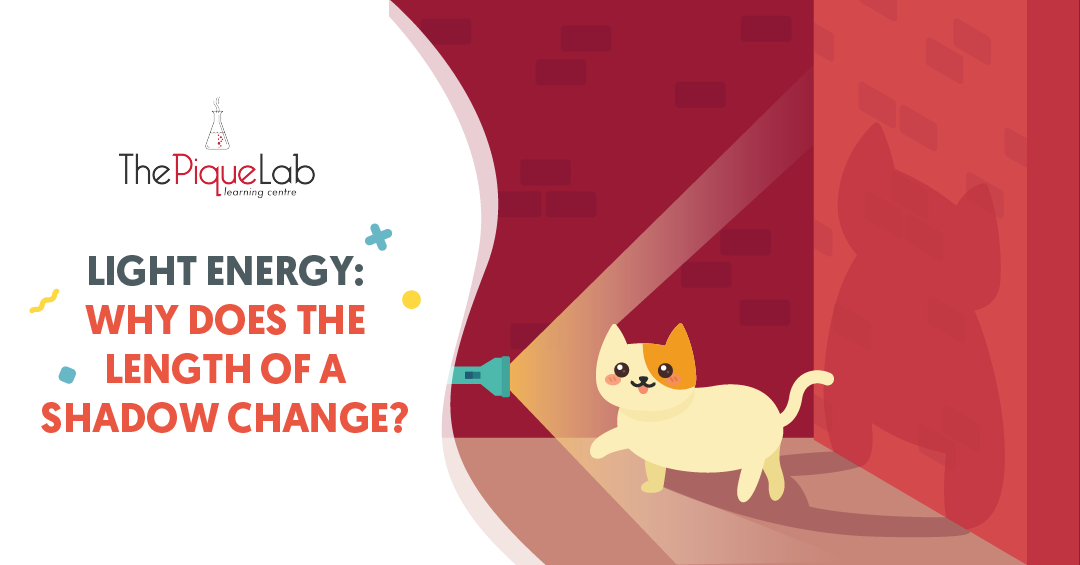Have you noticed your shadow occasionally changing in shape or disappearing when you enter a dark room?
Humans are not the only ones that can cast a shadow. There are many objects in our daily lives that can cast a shadow too, such as cupboards, soft toys and bags.
However, there are certain objects in our surroundings that do not cast a shadow, such as a clear glass cup and air.
So, how do we know which objects can cast a shadow and which objects cannot? Besides, why do the length of the shadows change at times?
In this article, I will be discussing about the conditions required for a shadow to be formed. After which, I will explain how the length of the shadow of an object changes when it moves from one place to another with reference to an examination question.
How Are Shadows Formed?
In order for a shadow to be formed, there are 3 conditions that have to be met:
- Light from a light source must be present.
- The object must be able to block light.
- There must be a screen for the shadow to form on.
Condition 1: Light must be present
In order for light to be present, it must come from a light source.
Can you recall some of the light sources that you have learnt?
Sources of light: Sun, torch light, fire
Condition 2: The object must be able to block light
When an object blocks light, it means that some light is unable to pass through the object. The amount of light that an object blocks depends on the transparency of the object. An object that blocks some light is known as a translucent object while an object that blocks most light is known as an opaque object. Thus, objects such as cupboards, soft toys and bags cast shadows as they are able to block light.
What about a clear glass cup? Why does it not cast a shadow? The reason is that a clear glass cup does not fulfill condition 2. The clear glass cup is transparent and does not block light. Thus, there is no shadow formed.
*⚠️ Misconception Alert*
The term “transparency” is different from the term “transparent”.
Transparency refers to the ability of an object to allow light to pass through it. The term “transparency” does not tell us how much light can pass through an object.
On the other hand, the word “transparent” indicates that most light is able to pass through the object, which tell us the amount of light that can pass through the object.
Condition 3: There must be a screen for a shadow to form on
Shadows can only form on objects that are able to block light. This includes both translucent (blocks some light/allows some light to pass through) and opaque (blocks all light/does not allow light to pass through) objects. Thus, we usually see shadows formed on the wall or on the floor.
Hence, in order to answer “How are shadows formed?”, we say that:
A shadow is formed when light from the light source, which travels in the straight line, is blocked by an opaque/translucent object.
A shadow can only be formed on translucent or opaque objects/surfaces.
Read Also:
With a better understanding of the conditions required for a shadow to be formed, let us now analyse why the length of the shadow changes, using the question below.
Question

Source: CHIJ St. Nicholas Girls’ School – 2016 P6 SA2 Examination Paper [Q22]
Before we start to analyse the question, let us first identify the transparency of the cat.
The cat does not allow any light from the lamp post (light source) to pass through. As such, the cat is opaque and would cast a shadow on the ground (the ground is opaque – recall that only translucent/opaque objects allow shadows to be formed on it).
Why does the cat’s shadow change in length when it walks from Point W to Z?
Note: The length of the shadow depends on the distance between the light source and the object, which affects the size of the shadow formed on the ground.
Let’s start from Point W
When the cat is at Point W, light rays from the lamp post are falling on the cat at the furthest distance. This causes the cat to block the greatest area of light from the lamp post, causing the length of shadow formed at Point W to be the longest.

Diagram 1
Moving from Point W to Point X
As the cat walks from Point W to Point X, the distance between the lamp post and the cat decreases, causing the length of the shadow to decrease. (Compare Diagram 1 and Diagram 2 drawn below) This would also mean that the cat is blocking a smaller area of light from the lamp post.

Diagram 2
At Point X
When the cat is directly below the lamp post at Point X, the distance between the lamp post and the cat is the shortest. Thus, the length of the shadow will also be the shortest. This is because light rays from the lamp post is only falling just above the cat, and the cat is blocking the SMALLEST area of light from the lamp post.

Diagram 3
Moving from Point X to Point Z
As the cat walks from Point X to Point Z, the length of the shadow will increase once again since the distance between the lamp post and the cat increases. This would also mean that the cat is blocking a GREATER area of light from the lamp post.

Point Z
When the cat is at Point Z, the distance between the lamp post and the cat is the furthest once again, causing the cat to block the GREATEST area of light. Hence, the length of shadow formed at Point Z would be the longest again.

Before I reveal the answer to you, I would like you to take a look at the question above again and choose your answer.
Answer

If you have chosen Option (2) as the answer, you are right!
In Conclusion
Allow me to quickly summarise what we have learned together:
#1: When the object (on the ground) moves further away (to the left or the right) from the light source, more area of light from the light source would be blocked by the object, causing the length of shadow to be longer.
In other words, if light from a light source falls on a larger exposed surface area of the opaque/translucent object, the length of shadow would be longer.
#2: Remember, in order for a shadow to be formed, there needs to be light coming from a light source.
#3: Also, do not forget that the object that is blocking the light and the screen where the shadow is formed on, must be either opaque or translucent.
I hope that this article has been beneficial in helping you understand the concepts being tested in questions on shadows from the topic of Light Energy.
Stay tuned for more articles!

If you like our methodology, we've some upcoming workshops:







